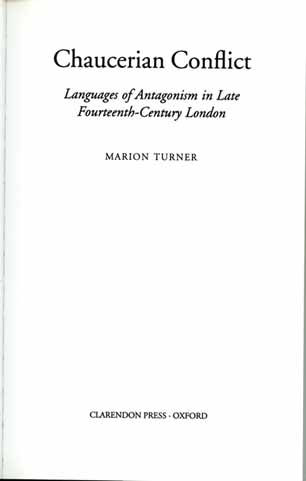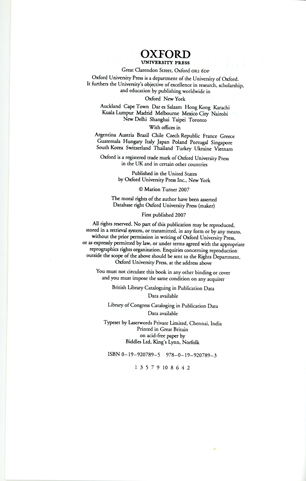Introduction: Citation of a Book
This tutorial begins with the simplest source to cite: a single-author book. Much of the information needed for a footnote will be found on the source's title-page and its reverse (see images below). A first footnote to a single-author book needs to identify the following information:
- Author's name (followed by a comma)
- Title of book (in italics, in full, with all principal words capitalised)
- Details of publication (enclosed in parentheses):
- Place of publication (followed by a colon)
- Publisher (followed by a comma)
- Date
- Page number(s) (preceded by a comma and 'p.' or 'pp.'; followed by a full stop)
Example

 (Click the right-hand image to enlarge the publication details)
(Click the right-hand image to enlarge the publication details)
In this simple example, if we were citing a passage on page fifty nine, the footnote should read:
Marion Turner, Chaucerian Conflict: Languages of Antagonism in Late Fourteenth-Century London (Oxford: Clarendon Press, 2007), p. 59.
Further Comments:
- Titles: the title should be given as it appears on the title-page. A colon should be used to separate title and subtitle, regardless of the form used on the title-page. The first word after the colon should be capitalised (even 'The', 'A', etc.)
- Place of publication: where a book has been published in more than one city (e.g. London and New York), you only need to give one place, which can be the first city named
- Publisher: The name of the publisher should be given without the definite article (so 'The Bodley Head' would be cited as 'Bodley Head') and without secondary matter such as '& Co.', 'Ltd', etc. (so 'Norton and co.' would be cited simply as 'Norton')
- Date: you should give the year of publication of the edition of the book you referred to
- Page numbers: page numbers should be given in the form 'p. 59' (for one page) or 'pp. 59-62' (for a range of pages)

